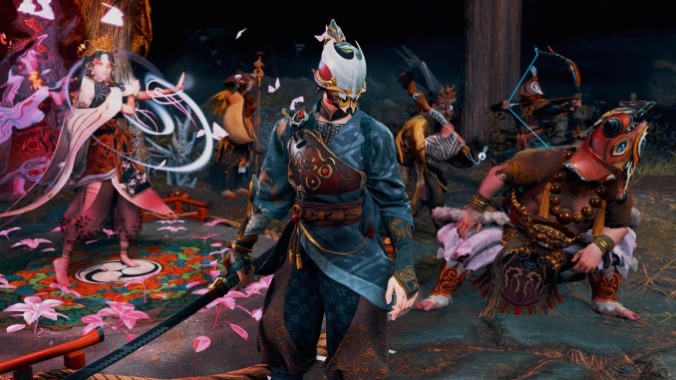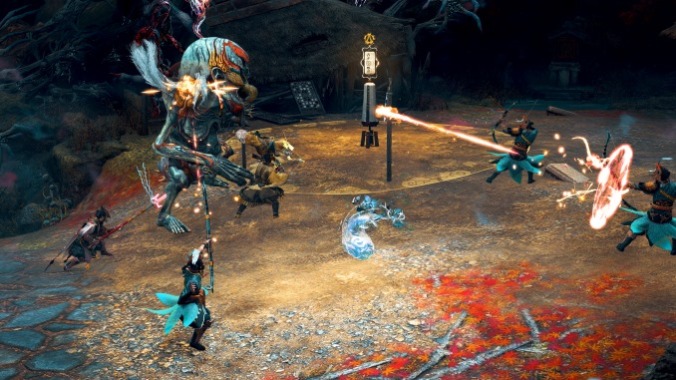Dance the Blight Away in Kunitsu-Gami: Path of the Goddess

All the Goddess wants to do is dance! Her villagers and soldiers, too. And even the supernatural warrior who protects her and gives orders to her citizen militia during battles against an omnipresent evil presence known as the Seethe that has corrupted their home of Mt. Kafuku. (That warrior’s the one you play as, natch.) Kunitsu-Gami: Path of the Goddess might be a tower defense-y, hackin’ ‘n’ slashin’ strategy game based on Japanese folklore, but dance is at its heart and all over the screen when you play it.
Let’s fill out that dance card. Soh, the mighty warrior you play as, twirls and arcs gracefully as he fights across the battlefield, and can pull off an even more choreographed strong strike called a “dance attack” during combos. Yoshiro, the titular Goddess, does a long, slow ceremonial Kagura dance from one side of the stage to the other, cleansing it of the Seethe’s defilement along the way. The villagers who you purify and conscript into battle have dance-like motions of their own during combat. At the end of the stage, when you and your crew have successfully protected Yoshiro the whole way, the entire squad teams up for a line dance to purify the corrupted torii gate through which the Seethe’s hordes of monstrous critters rush through. Even in the face of a fate worse than death, Yoshiro and her followers have time to lose themselves in dance.
(I’m pretty sure Dance Attack released a 12” on 99 Records back in the day, by the way.)
As dance-centric as Kunitsu-Gami is, you don’t actually control those dances. Each stage is broken into two phases. The first is the purification process; as you move down Mt. Kafuku you’ll enter increasingly dangerous corrupted villages. During the daytime, you guide Soh through a village with a few specific goals: you can purify various large pockets of Seethe energy, which grants you crystals; you can have your carpenter rig up various obstacles and traps to help you during the nighttime battle; and you can purify villagers trapped by the Seethe and assign them each a different role for the fight ahead. (You can also sometimes find rations in smashable jars and by purifying wildlife, which can be used to heal your villagers during battle.) Most importantly, Yoshiro can only dance down the Spirit Path towards the torii gate during the daytime; once the sun sets, which happens after a set amount of time every day, she stands in place, exposed to demon attacks.
Nighttime is fight time in Kunitsu-Gami. At night defiled torii gates sprout giant, wrinkled heads as demons start to pour out of them, with the Goddess as their target. (She’s the tower, and Soh and the villagers are the defense.) Again, you can’t directly control anybody but Soh, so you need to issue orders to your soldiers throughout the fight—changing roles if necessary and moving them across the three-dimensional, usually multi-level map. You can also fight demons as Soh, slashing away with your sword and building up those dance attack combos. The assault stops when the sun rises again, at which point you have another daytime cycle to inch Yoshiro further down the Spirit Path and, if necessary, prep for another night of beating back demons. The only way to complete a stage is to get Yoshiro all the way to the end and do your little dance to purify the torii gate.
Friends, that’s just one of the two phases.
The other is a fairly barebones city builder mode. After purifying a stage, you can revisit it and fix it up by assigning villagers to different repair tasks. That’s basically all there is to it, although it’ll almost always take two or more turns to fully clean up a village. Once you’ve finished all the repairs, Yoshiro will grant you various power-ups, from increasing your max amount of crystals (which are used to power Yoshiro’s Spirit Path dance and also to pay for assigning or changing your villager’s roles), to granting you new special attacks or passive perks.
-

-

-

-

-

-

-

-

-

-

-

-

-

-

-

-

-

-

-

-

-

-

-

-

-

-

-

-

-

-

-

-

-

-

-

-

-

-

-

-









































